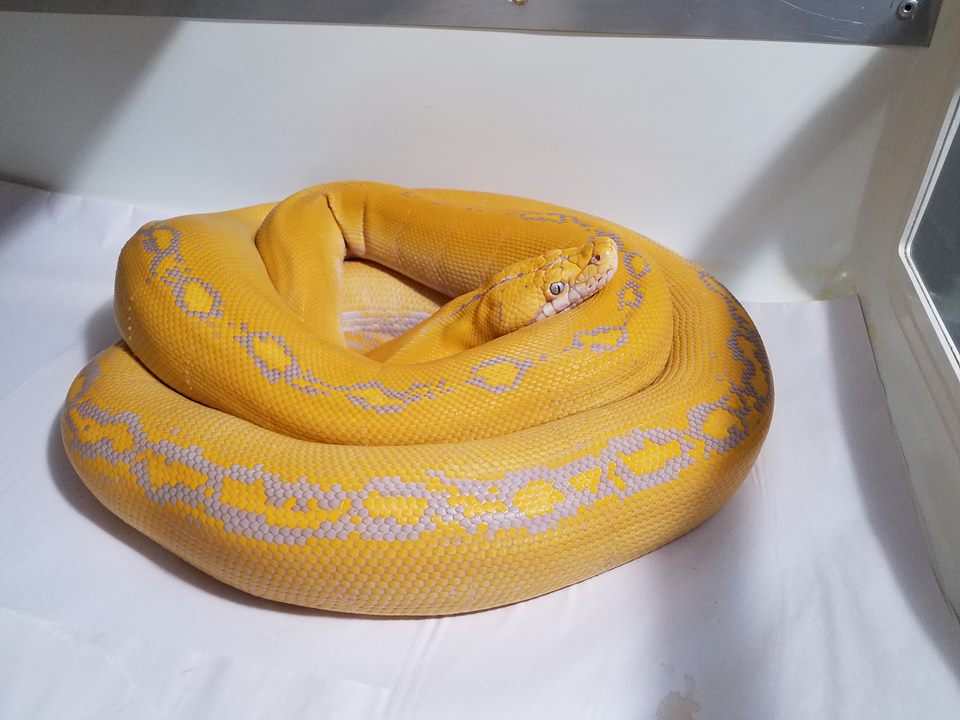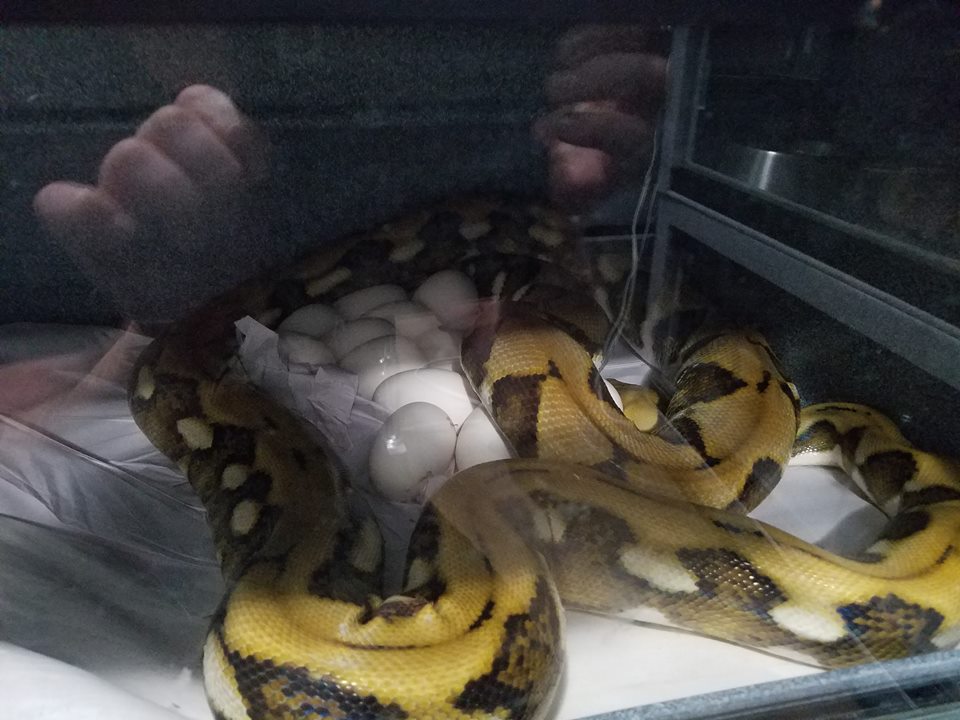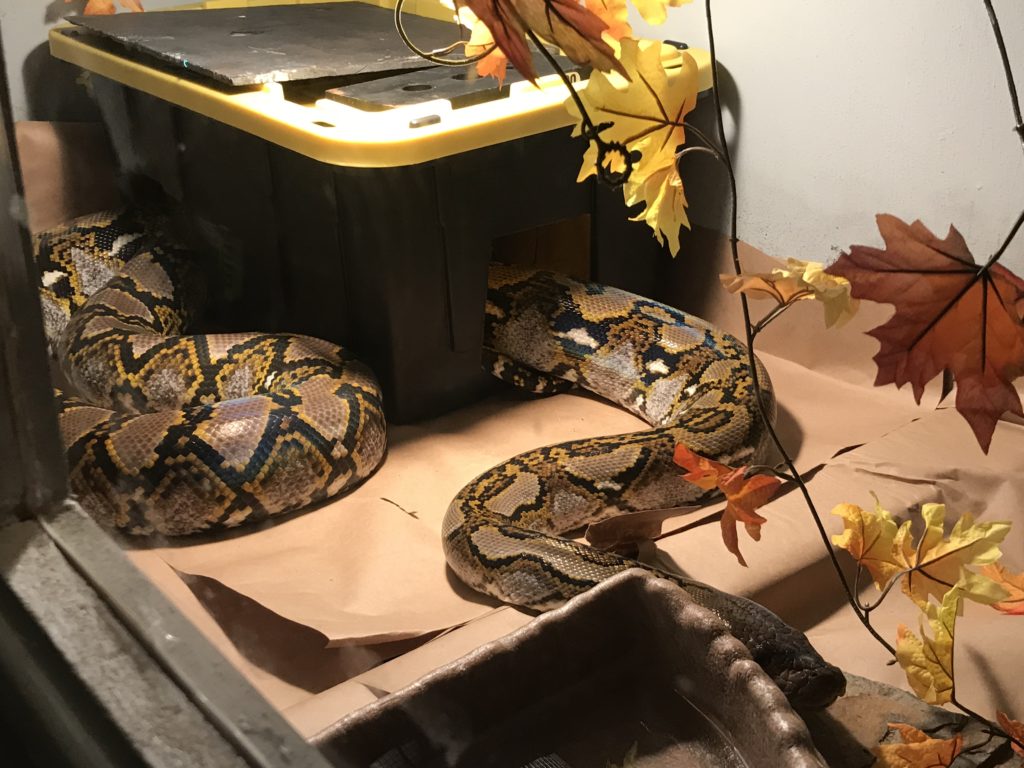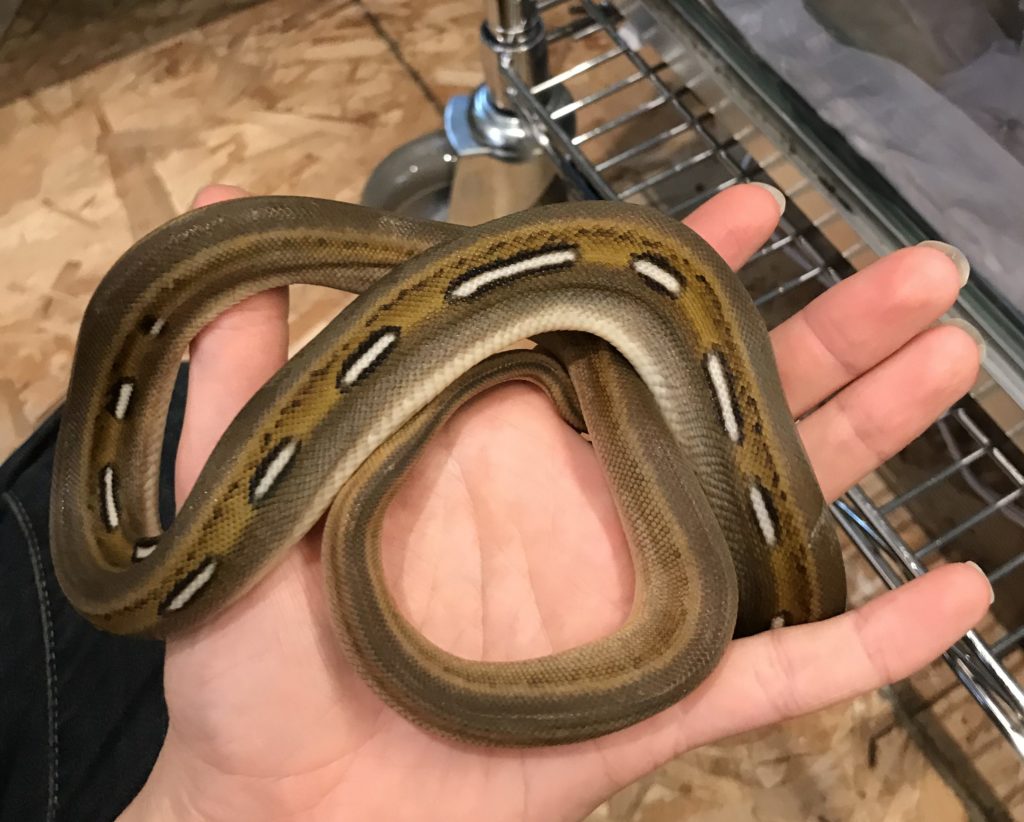under construction . . . Please bear with us as we continue to add and refine this section.
In this section we are talking about how an individual’s GENOTYPE causes their PHENOTYPE. Lets try to keep this simple.
Pictured: Valac, Lilith, and Legend. These are all mainland reticulated pythons with different phenotypes. Valac is a normal, or wild type, which means he is what most reticulated pythons in the wild will look like. Lilith is a purple albino and Legend is a titanium. Let’s learn about how their genes create these different looks.
Heterozygous vs Homozygous
These terms are used to indicate the number of gene copies there are. Each gene has two different versions. The different versions of that gene change how strong of an influence it has on phenotype.
For example let’s consider the mythical Color Square animal.
Here we have two different phenotypes: BLUE and yellow. The BLUE version of the color gene is dominant and the yellow version is recessive.
- Homozygous: two BLUES or two yellows
- Heterozygous: one BLUE and one yellow in the same animal

In this example the color squares on each end are homozygous. The one in the middle is heterozygous.
Dominant or Recessive
The color squares in that first example also show DOMINANT and recessive, but let’s dig a little deeper to gain a more thorough understanding. In case you have not yet noticed – for our purposes DOMINANT will be in capitals and recessive will be in lower case.

Above are two examples of Homozygous parents with the same geneotype creating homozygous offspring. The parents on the left are homozygous DOMINANT. The parents on the right are homozygous recessive. Their offspring will all be the same genotype as the parents.
The DOMINANT copy of a gene will always show in the phenotype whether there are 1 or 2 copies of it. The recessive copy must be there twice in order to show in the phenotype. See below for a graphic to visualize this.

Here is what happens when two homozygous parents of DIFFERENT genotypes create offspring.
When a homozygous DOMINANT mates with a homozygous recessive all of the offspring will be heterozygous and will show the phenotype of the DOMINANT parent.
Now go one layer deeper:

Heterozygous parents create offspring that are not all the same.
25% of them will be homozygous DOMINANT. 50% will be heterozygous. 25% will be homozygous recessive and since BLUE is dominant 3 out 4 offspring will be BLUE and only 1 will be yellow.
And even deeper:
Crossing a homozygous parent with a heterozygous parent has different results depending on DOMINANT vs recessive.

Punnet Square:
The Punnet square is a simple tool used to help you figure out what probable gene combinations exist in a certain pairing. Here’s how it works: put one parent’s genotype on the top and the other parent’s genotype down the side of the box, then follow across or downward to see what the offspring will be.
Each 1/4 of the Punnet square represent 25% of the offspring however, we must remember this gives us the PROBABILITY of each type. It does not guarantee those numbers. The laws of probability tell us that a larger clutch will result in numbers closer to these probabilities, but in a small clutch all bets are off.

For example if the square to the right here is produced by a mainland reticulated python the clutch may contain 60 eggs. With that many eggs you could likely get these different combinations:
- 16 homozygous BLUE, 32 heterozygous blue and 12 homozygous yellow
- 20 homozygous BLUE, 29 heterozygous blue and 12 homozygous yellow
- 12 homozygous BLUE, 40 heterozygous blue and 8 homozygous yellow
If that square on the right is produced by a super dwarf reticulated python you might only get 8 eggs total. In which case you could get the following:
- 5 homozygous BLUE, 2 heterozygous blue, and 1 homozygous yellow
- All 8 heterozygous blue
- All 8 homozygous BLUE
See what I mean? It’s only probabilities, but nature ultimately will decide on her own what she creates.
Co-dominant vs Incomplete dominant
Now this is where many people get confused. Co-dominant and Incomplete dominant genes are simply different types of dominance. They express themselves differently and therefore have different effects on phenotype.
- Co – dominant: each version of the gene shows itself equally because they express themselves in different ways.
- Incomplete dominant: These genes compete with each other, but are both dominant, so they blend together to create a 3rd intermediate phenotype.
In the graphic below you see a color square example of each. The top example is Co-dominant where the resulting offspring show BOTH colors in the same way as seen in each parent but overlapping. In co-dominance the offspring share/show both traits equally. Here it is seen as yellow stripes over a blue background. The second example is Incomplete dominance where each color competes, and neither wins, creating a blending of the two that looks different from each parent. The offspring here are neither blue, nor yellow, but are blended into the new color green instead.

Co-dominant
Incomplete
Use this memory trick to keep these strait:
- Co-dominants co-operate and therefore both show up.
- Incomplete compete! and neither win
Now let’s explore these concepts in a real live clutch.
The parents are seen here in these two pictures:

DAD 
MOM
The male is a Purple Albino Citrus Goldenchild seen on the left. On the right is the female seen in the process of laying her eggs. She is a Citrus Tiger Het-Albino.
By combining these two as parents we have the following genes:
- Normal: The normal phenotype will show in the absence of other genes.
- Citrus: From what I have been told, this is a trait similar to locality and sort of results in a hypo like look. Both parents are Citrus so it will carry through to all the babies. We will ignore this gene for the rest of the discussion.
- Albino: A recessive gene and we will refer to is with a small letter “a” . For albino to show up the baby will need to be homozygous for albino = aa
- Tiger: A co-dominant gene and will be referred to with a capital letter “T”. TT super tiger
- Golden Child: Another co-dominant gene that will be referred to with a capital “G”.
So we have a clutch pairing of two co-dominant genes that may combine and a simple recessive.
The genotype of the parents are:
Ggaa x TtAa
Go through the Punnet square below to see the babies that were produced!

(Credit for photos and this spectacular clutch goes to Brian Cimala)




